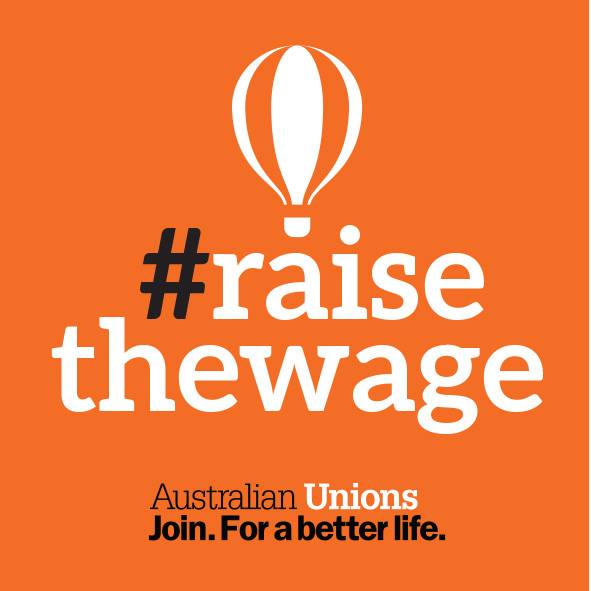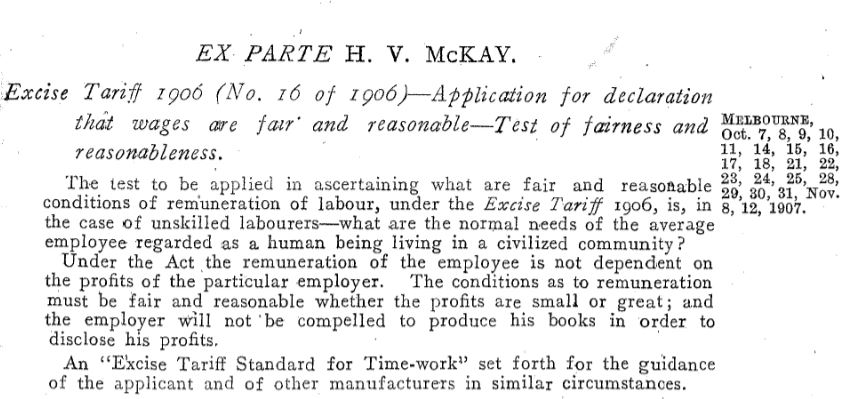Campaigns

Latest News
-
Check your pay if you’re working under an award
09 July 2018 -
Qantas mega-profits trickle up... not down
14 February 2018 -
Tax Justice Network report reveals ExxonMobil must face questions on tax
04 December 2017 -
ACTU calls for Living Wage on 110th anniversary of Harvester Decision
02 November 2017 -
Wages are going backwards - rules at work are broken
17 August 2017
Minimum Wage & Award Safety Net Review
Making a minimum wage a living wage
Each year, unions apply to increase minimum wage rates during the Fair Work Commission's annual wage review process. This is to ensure that both the National Minimum Wage and the award safety net keep pace with the rising cost of living. Not all employees are in workplaces where enterprise bargaining is the main engine driving pay increases, so the safety net review is critical to ensure all workers keep pace with inflation and receive fair reward for their labour in Australia.
The annual wage review of the award safety net will affect rates of pay set by enterprise agreements only where the rates in an agreement fall below rates in the relevant award/s. Please contact your ASU Branch for further details if you believe this affects you.
A timeline of wage reviews is below, showing the increases, along with historical details and other information.
Read the entries listed by year below, or summarised here: ![]() Summary of National Minimum Wage Increases from 1991 onwards
Summary of National Minimum Wage Increases from 1991 onwards
2018
On 25 June 2018, the Fair Work Commission awarded an increase of 3.5% to minimum award wages (lifting the Minimum Wage to $18.93 per hour ). The ASU advised members of the decision and to: Check your pay if you’re working under an award. The decision was well below the union claim for a $50 per week increase to minimum wages and does not redress the growing wealth inequality being seen in Australia. A $50 per week increase would have brought the minimum wage towards the ACTU’s target of a living wage that is 60 percent of the median wage. Click here for the FWC decision.
2017
On 6 June 2017, the Fair Work Commission awarded an increase of 3.3% to minimum award wages (which equates to $22.20 per week in the National Minimum Wage – less than half our claim). Read about the decision here: Commission awards highest increase in five years but leaves low paid in poverty. Earlier in the year, new ACTU Secretary Sally McManus announced the union movement's claim for the 2017 minimum wage review and explained during her National Press Club address why the claim was higher than usual: Minimum wage must be increased by $45 a week to avoid American-style working poor (ACTU release). With wages stagnating and attempts at unilateral pay cuts like the penalty rates decision, unions are standing up to fight for the balance to be redressed.
2016
On 31 May 2016 the decision handed down by the Fair Work Commission awarded an increase of 2.4% (lifting the Minimum Wage by $15.80 per week). Read about the decision here: Minimum wage rise not enough for 1.8m lowest paid Australians. Click here for the FWC decision. The decision was well below the union claim for a $30 per week increase to minimum wages and does not redress the growing wealth inequality being seen in Australia. Read more about the union claim here: Two million workers need $30 week increase to avoid becoming US-style working poor. More information can be found on the Fair Work Commission website for the 2015-2016 review.
2015
The decision handed down by the Fair Work Commission on 2 June 2015 awarded an increase of 2.5% (lifting the Minimum Wage to $656.90 per week or $17.29 per hour). Read about the decision here: Lowest paid workers continue to do it tough despite $16 pay rise. Click here for the FWC decision. The decision was well below the union claim for a $27 per week increase to minimum wages and in respect of award minimum rates, unions sought $27 per week increases for all classifications up to and including the C10 tradesperson rate and a 3.6% increase for award rates above the C10 rate. Read more about the union claim here: $27 pay rise and 10 per cent super for minimum wage workers. More information can be found on the Fair Work Commission website for the 2014-2015 review.
2014
The Fair Work Commission handed down a low award safety net increase of 3% (or $18.70 a week for the Minimum Wage) on 4 June 2014. Read about the decision here: Aussie 'fair go' elusive for our lowest paid workers. Click here for the FWC decision. The ACTU and unions had applied for an increase of $27 to the minimum wage: $27 minimum wage increase needed now. Click here to read the ACTU Submission for the Annual Wage Review. Unfortunately, 2014 has also seen the minimum wage attacked by the Abbott Government's Commission of Audit report which recommends cutting it every year for 10 years, then getting rid of it altogether. Read more here: Government plan to cut minimum wage every year for ten years a savage blow to Australia's lowest paid and follow the news here: www.asu.asn.au/news/minwage
2013
On 3 June 2013, the Fair Work Commission awarded an increase of 2.6% to award wages, lifting the National Minimum Wage by $15.80 a week from 1 July 2013. Read about the decision here: Wage gap will widen after today's disappointing decision by Fair Work Commission. The unions had applied for an increase of $30 to the minimum wage this year. Read more about the application here: Unions seek $30 minimum wage rise to prevent lowest paid from falling even further behind.
2012
On 1 June 2012, Fair Work Australia awarded a percentage increase of 2.9% to award wages, which will result in lifting the National Minimum Wage by $17.10 a week to $606.40 or $15.96 an hour from 1 July. You can read about the increase here: Minimum wage decision will widen the gap between the low-paid and the rest of workforce. For information about the unions' initial application on 16 March 2012 for an increase of $26 per week to the minimum wage please see: Unions call for a $26 wage rise to help our lowest paid catch up to average earnings.
2011
On 3 June 2011, Fair Work Australia awarded a percentage increase of 3.4% to award wages, which amounts to lifting the National Minimum Wage by $19.40 a week to $589.30 or $15.51 an hour from 1 July. You can read about the increase here: Lowest paid workers get a $19.40 wage rise, but still not enough to bridge gap*. For information about the initial union submission for a $28 a week increase in the minimum wage, lodged on 18 March 2011, see: Unions call for a decent wage rise to ensure our lowest paid are not left behind*. (*Contact webkeeper@asu.asn.au for these archived resources.)
2010
On 3 June 2010, the new Fair Work Australia Minimum Wage Panel (replacing the WorkChoices era AFPC) awarded $26 to award-dependent workers. You can read about it here: Working Australians get a $26 a week dividend for end of WorkChoices*. For more information about the unions' initial claim for $27, visit our earlier news item: Low paid workers must share in the economic recovery; unions to seek $27 a week wage rise*. (*Contact webkeeper@asu.asn.au for these archived resources.)
2009
On July 7, 2009, the AFPC in its final decision before being disbanded, shocked the community (and, tellingly, the usually dispassionate journalists covering the event) by announcing a pay freeze on award wages. You can read about it here: "Working Australians to suffer as WorkChoices-era pay commission saves its worst for last"*. For more information about the unions' initial claim for $21, visit our earlier news item: "Unions push for $21 a week pay rise for low-paid workers to stimulate economy and safeguard jobs"*. (*Contact webkeeper@asu.asn.au for these archived resources.)
2008
On July 8, 2008, the AFPC announced its decision on the minimum wage review. The Commission has granted an increase of $21.66 a week, or 57 cents an hour, to the federal minimum wage and Australian award pay and classification scales. Unlike in previous years, the 2008 decision is not differential, and applies uniformly to all minimum rates of pay in the pay scales. The decision takes effect from the first pay period on or after 1 October 2008. Further details about the decision can be found here: "Minimum wage pay decision begins to repair damage done by WorkChoices"*. The unions had sought an increase of $26 per week to the minimum wage. Further details can be found in our related news article "Give low paid workers $26 a week pay rise"*. (*Contact webkeeper@asu.asn.au for these archived resources.)
2007
On July 5, 2007, the AFPC announced its decision on the minimum wage review. It has increased the standard Federal Minimum Wage and all Pay scales as follows: $10.26 per week, for those earning less than $700 a week and $5.30 per week, for those earning more than $700 per week. Both increases apply from the first pay date on or after 1 October 2007. Read more here: Lowest pay rise for 10 years*. (*Contact webkeeper@asu.asn.au for these archived resources.)
2006
On October 26, 2006, the AFPC finally handed down its decision on the minimum wage review. Following an AIRC determination, an increase of $27.40 per week to the Federal Minimum wage and to minimum 'award' rates of pay below $700 per week and an increase of $22.00 per week to rates above $700 will be applied. Increases operate from 1 December 2006. For more details, go to: "Low paid win $27 per week increase"*. Despite the delays created by the Federal Government's new laws, unions attempted to ensure that at least as many workers as possible had access to fair pay increases in 2006 by commencing wage cases in the State tribunals. To find out more, go to: "Unions push for wage increase in the face of rising costs for working families"*. (*Contact webkeeper@asu.asn.au for these archived resources.)
2005
The Australian Industrial Relations Commission awarded $17 in the 2005 Minimum Wage Case on June 7 2005. The claim made by unions in this round was for $26.60 a week. Although it was not reached, the AIRC decided on an amount which was greater than that being asked by employers and the Federal Government, a miserly $10-$11. State and Territory governments supported $20. This is likely to be the last national wage increase determined by the independant AIRC after a century of tradition. The Federal Government intends to have future wage increases set by a new government run agency which if set up in 1996 would have delivered $50 less to workers based on Commonwealth submissions over the last 8 years.
2004
The Australian Industrial Relations Commission awarded $19 in the 2004 Minimum Wage Case on May 5, 2004. The claim made by unions in this round was for $26.60 a week but although it was not reached, the AIRC decided on an amount which was far greater than that being asked by employers and the Federal Government, a miserly $10. State and Territory governments were much more in step by supporting $20.
2003
In the 2003 round of the Minimum Wage Case (the traditional name for the Living Wage Case has been used this round) the ACTU sought a $24.60 a week increase. The Commission granted a two tiered increase: $17 per week for those earning up to and including $731.80; and $15 workers on over $731.80.
2002
The ASU claim in this years National Wage Case, coordinated by the ACTU, was for an increase of $25 per week, but a Full Bench of the Commission granted $18 instead (with the Federal Government and employer groups asking for only $10).
2001 and earlier
If you are interested in the earlier Wage Cases, have a look at our Summary of National Minimum Wage Increases from 1991 onwards. If this doesn't answer your query, please send us an e-mail.
1907
The Harvester Judgment created the basis for the Australian system of the minimum wage as a living wage - see special section below for further details about this historic case that contributed significantly to Australia's touted national value of egalitarianism - a fair go for all.
There is often confusion about these two distinct but closely interrelated things, so here is a brief explanation. Contact your ASU Branch if you need further information.
If a worker is not covered by any existing award, they are to be paid at the very least the wages specified in the "Minimum Wage Order", an industrial instrument which is reviewed every year, ostensibly so that it keeps up with increases in living costs. The Minimum Wage Order is not an award.
The annual review of the Minimum Wage Order also applies the same decision to "minimum award wages", the rates of pay specified in all awards formalised in the federal industrial jurisdiction. As explained elsewhere on this page, changes to minimum award wages affect workers covered by awards who are either (a) not covered by an enterprise agreement or (b) who are covered by an enterprise agreement whose pay rates have fallen behind the related award wage rates.
How many workers are covered by the "Minimum Wage Order" versus "minimum award wages" versus "enterprise agreements"? These numbers are constantly changing, for example, as unions negotiate more agreements over time. The Australian Bureau of Statistics (ABS) used to produce an annual "Australian Labour Market Statistics" report that provided statistical information about the numbers of workers in various categories, but this report was last compiled in 2014 and is no longer updated.
More information and the current Minimum Wage Order can be found on the Fair Work Commission website here: www.fwc.gov.au - Minimum Wage Orders.
Our involvement in annual wage reviews underlines the ASU's commitment to assisting workers who do not have access to enterprise bargaining pay increases. It is the most low paid in our society that seek to keep pace with the rising cost of living through the unions' work in the Annual Wage Review. Our aim is to ensure that the Minimum Wage and minimum award wages keep pace with inflation and are a living wage for those receiving it, ie. a full time worker on a minimum wage should not live in poverty.
It is also important to remember that minimum wages are an important part of the structure of wages of all workers. If minimum wages are undermined, everyone's wage could be at risk.
On 8 November 1907, Justice H B (Henry Bournes) Higgins of the Commonwealth Court of Conciliation and Arbitration ruled in the "Harvester Case" that employers are required by law to provide all workers with, at minimum, a wage that met "the normal needs of an average employee, regarded as a human being in a civilised community".
The minimum wage as a living wage was born. From then on, increases to Australia's minimum wage were argued on the basis of what was deemed to provide a living wage to a worker living in "frugal comfort".
For the legal history buffs, the case citation is: Ex parte H.V. McKay (1907) 2 CAR 1
- Click here for the full text of the Harvester Judgment
- More information for school students
- More information and related links from Wikipedia

Michael Rizzo is the National Officer responsible for the ASU's involvement in minimum wage review matters. For further information, please contact Michael.

